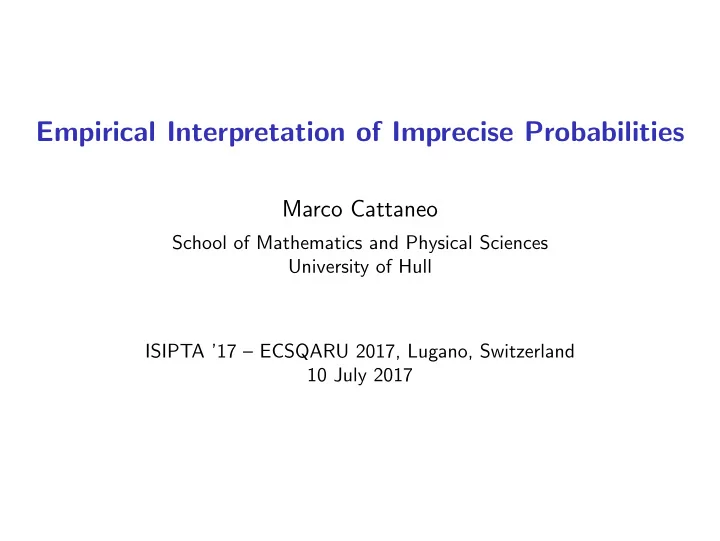

Empirical Interpretation of Imprecise Probabilities Marco Cattaneo School of Mathematics and Physical Sciences University of Hull ISIPTA ’17 – ECSQARU 2017, Lugano, Switzerland 10 July 2017
introduction ◮ imprecise probabilities can have a clear empirical/frequentist meaning only if they can be estimated from data ◮ consider for example a (potentially infinite) sequence of bags containing only white and black marbles: we draw one marble at random from each bag, where the proportion of black marbles in the i -th bag is p i ∈ [ p , p ] ⊆ [0 , 1] ◮ if p = p , then [ p , p ] represents a precise probability (P), which can be estimated from data without problems (Bernoulli, 1713) ◮ if p < p , then [ p , p ] represents an imprecise probability (IP): can it still be estimated from data? Marco Cattaneo @ University of Hull Empirical Interpretation of Imprecise Probabilities 2/8
interpretations of [ p , p ] ◮ which sequences of proportions p i are compatible with the IP [ p , p ]? ◮ epistemological indeterminacy interpretation (Walley and Fine, 1982), used e.g. in the theory of Markov chains with IPs (Kozine and Utkin, 2002): p i = p ∈ [ p , p ] ◮ ontological indeterminacy interpretation (Walley and Fine, 1982), used e.g. in the theories of Markov chains with IPs (Hartfiel, 1998) and probabilistic graphical models with IPs (Cozman, 2005): p i ∈ [ p , p ] ◮ id-ontological (identifiable ontological indeterminacy interpretation), making [ p , p ] identifiable: � � p i ∈ [ p , p ] = lim inf i →∞ p i , lim sup p i i →∞ Marco Cattaneo @ University of Hull Empirical Interpretation of Imprecise Probabilities 3/8
levels of estimability of [ p , p ] ◮ assuming that we have a sufficiently large number n of drawings ◮ ideal: uniformly consistent estimability, meaning that we can construct arbitrarily short confidence intervals for p and p with arbitrarily high confidence levels ◮ minimal: IP-consistent estimability (i.e. consistent in terms of IPs), called strong estimability by Walley and Fine (1982), and almost equivalent to the testability of [ p , p ] with arbitrarily low significance level and arbitrarily high power for a fixed alternative ◮ inadequate: P-consistent estimability (i.e. consistent in terms of Ps), meaning that p and p can be estimated arbitrarily well under each compatible sequence p i , but the level of precision of the estimator can depend on the particular sequence p i Marco Cattaneo @ University of Hull Empirical Interpretation of Imprecise Probabilities 4/8
estimability of [ p , p ] interpretation of [ p , p ]: epistemological: ontological: id-ontological: necessary and p i = p ∈ [ p , p ] p i ∈ [ p , p ] p i ∈ [ p , p ] s.t. sufficient conditions p = lim inf i →∞ p i , on possible [ p , p ]: p = lim sup p i i →∞ ideal: pairwise disjoint pairwise disjoint pairwise disjoint estimability of p , p : uniformly consistent and IPs isolated and IPs isolated and IPs isolated minimal: pairwise disjoint pairwise disjoint pairwise disjoint IP-consistent inadequate: pairwise disjoint pairwise disjoint ? P-consistent Marco Cattaneo @ University of Hull Empirical Interpretation of Imprecise Probabilities 5/8
estimability of [min { p 1 , . . . , p n } , max { p 1 , . . . , p n } ] interpretation of [ p , p ]: estimability of min { p 1 , . . . , p n } , max { p 1 , . . . , p n } : epistemological: ontological: id-ontological: necessary and p i = p ∈ [ p , p ] p i ∈ [ p , p ] p i ∈ [ p , p ] s.t. sufficient conditions p = lim inf i →∞ p i , on possible [ p , p ]: p = lim sup p i i →∞ ideal: no IPs no IPs uniformly consistent minimal: no IPs no IPs IP-consistent inadequate: no IPs ? P-consistent Marco Cattaneo @ University of Hull Empirical Interpretation of Imprecise Probabilities 6/8
conclusion ◮ IPs [ p , p ] can be empirically distinguished only if they are disjoint ◮ finite-sample IPs [min { p 1 , . . . , p n } , max { p 1 , . . . , p n } ] cannot be estimated from data ◮ the paper summarizes several results that are not surprising, but important to clarify the limited empirical/frequentist meaning of IPs ◮ examples of estimators with the required properties are given in the paper Marco Cattaneo @ University of Hull Empirical Interpretation of Imprecise Probabilities 7/8
references J. Bernoulli. Ars Conjectandi . Thurneysen Brothers, 1713. F. G. Cozman. Graphical models for imprecise probabilities. International Journal of Approximate Reasoning , 39:167–184, 2005. D. J. Hartfiel. Markov Set-Chains . Springer, 1998. I. O. Kozine and L. V. Utkin. Interval-valued finite Markov chains. Reliable Computing , 8:97–113, 2002. P. Walley and T. L. Fine. Towards a frequentist theory of upper and lower probability. The Annals of Statistics , 10:741–761, 1982. Marco Cattaneo @ University of Hull Empirical Interpretation of Imprecise Probabilities 8/8
Recommend
More recommend